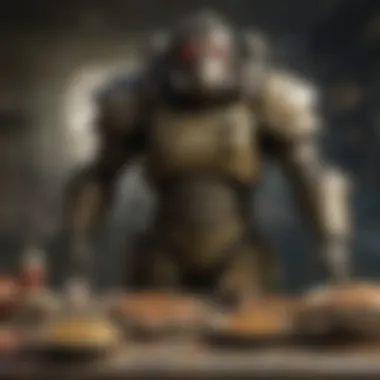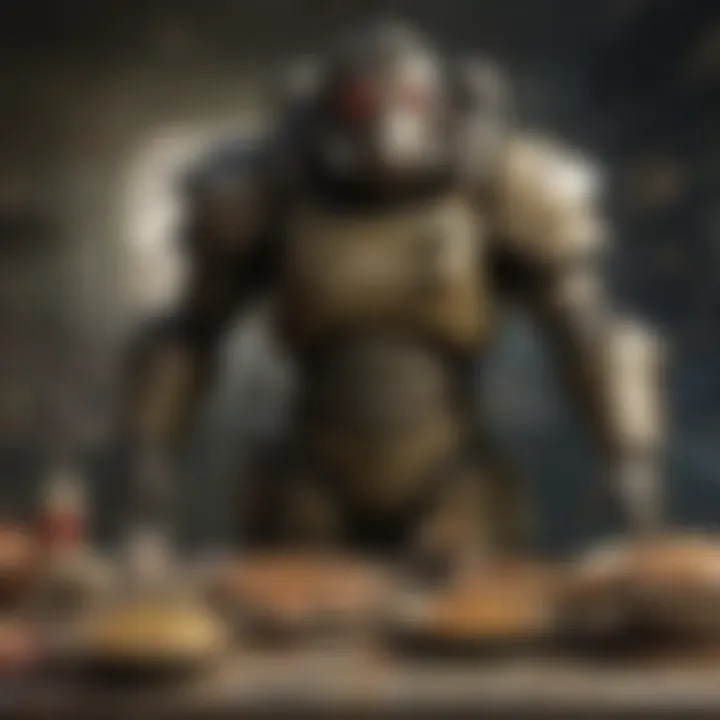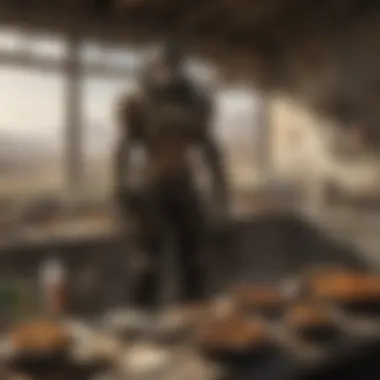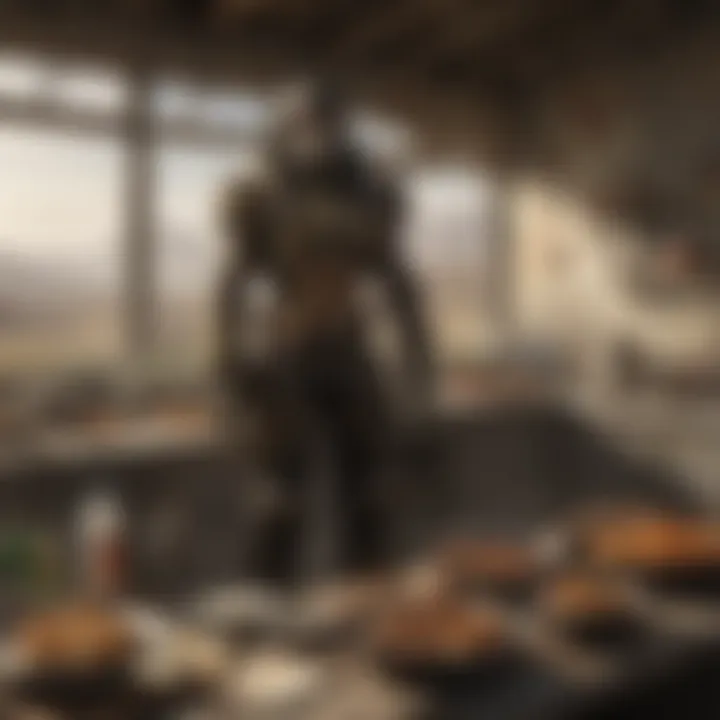Culinary Adventures in the Fallout Cookbook


Intro
The Fallout universe stands as a unique tapestry woven from threads of post-apocalyptic themes, complex narratives, and cultural references. With its rich lore and colorful characters, it’s no wonder that fans have sought ways to engage more deeply with this fictional world. One of the most interesting ways to do this is through the Fallout Cookbook. This culinary guide doesn’t merely present recipes; it serves as a passport to the various aspects of the Fallout experience, mixing gaming and gastronomy in a delightfully immersive manner.
The recipes found in this book draw inspiration from the game's diverse factions and locations, pulling readers into a melting pot of flavors that speak not only to their palates but to the lore of the wasteland itself. From irradiated sandwiches to perfectly cooked mirelurk meat, each dish offers a taste of the post-apocalyptic life while allowing fans to step into the shoes of their favorite characters.
This article will venture into the thematic significance of these recipes, the cultural nods embedded within their instructions, and how they engage both veteran players and newcomers alike. By examining the narrative behind each dish, we’ll see how food serves as a bridge to deeper understanding of the game’s lore, revitalizing the connection between players and the expansive world of Fallout.
Lore Insights
As we embark on this culinary journey, let’s first ground our exploration in the lore of the Fallout universe.
Overview of the Fallout Universe
The Fallout series is set in a post-apocalyptic world, a stark contrast to the bustling pre-war society depicted at its outset. After a nuclear apocalypse devastated civilization, humanity has had to adapt, forming new societies that reflect both the remnants of the old world and the realities of survival in a harsh environment.
Food, in this context, becomes a vital lifeline, representing both sustenance and cultural identity. Through its recipes, the Fallout Cookbook showcases how food evolved as a symbol of resilience amidst chaos. It highlights the ingenuity of survivors who have repurposed whatever they can find—be it radroach or deathclaw—into meals that tell stories of struggle, camaraderie, and survival.
Key Historical Events in the Fallout Timeline
Several key events have shaped the world of Fallout, impacting the culinary landscape as well:
- Great War of 2077: This catastrophic event set the stage for the Fallout universe. The resulting nuclear fallout forced remnants of humanity into underground vaults, changing their relationship with food forever.
- The Post-War Era: As survivors emerged from shelters, they faced scarcity and engineered a way of life based on what was available—often mutated or radioactive ingredients.
- The Rise of Factions: Groups like the Brotherhood of Steel, the Institute, and the New California Republic brought their own values and culinary customs, blending pre-war recipes with available resources.
Deep Dive into the Backstory of Major Factions and Characters
The recipes in the Fallout Cookbook often pay homage to prominent factions and characters, bridging their unique stories with culinary experimentation. For instance, the Brotherhood of Steel, with its focus on technology and preservation, is reflected in recipes that use preserved foods that harken back to a time before the apocalypse. The variability of ingredients mimics the faction’s resourcefulness in adapting to a changed world.
“Food in Fallout is not just about sustaining life; it's about redefining identity in a fractured society.” — Anonymous
As we explore the recipes, each one becomes a reflection of the history and complexity of the Fallout universe, engaging players on multiple levels.
In the upcoming sections, we shall delve into the specific recipes and their connections to this rich lore, highlighting how the Fallout Cookbook offers not only nourishment but also a deeper appreciation for the narratives that inspired it. By crafting meals inspired by the game, players are not just feeding their bodies but their imaginations as well.
Preamble to the Fallout Cookbook
The Fallout Cookbook represents more than just a collection of recipes. It serves as a unique bridge between the dystopian universes illustrated in the Fallout video games and the culinary realm. This synergy allows fans to engage with cherished themes from the games while exploring new flavors and cooking techniques. Through this cookbook, readers are invited to immerse themselves in the post-apocalyptic setting not just visually but also through taste, enhancing their overall experience with the franchise.
The importance of this cookbook lies in its ability to contextualize the rich narratives of the games in a tangible way. It reimagines the often grim circumstances of the Wasteland by presenting recipes steeped in creativity and historical references to pre-war cuisine. This fusion offers culinary enthusiasts a sense of adventure and an opportunity to think outside the traditional cookbook box.
By exploring the Fallout Cookbook, readers find that cooking becomes an echoed sentiment in the gaming lore. Each dish captures an essence of survival and resilience, mirroring the journeys of beloved characters. In essence, this step away from standard cookbooks is not simply to dish out food ideas but rather to connect players with the heart of the game through their culinary exploits.
The Impact of Fallout on Popular Culture
The Fallout franchise has steadily woven its influence through various facets of popular culture since the release of the original game in 1997. The mixture of post-apocalyptic themes, dark humor, and rich storytelling has left an indelible mark on gaming communities around the world. Elements like the distinctive aesthetic, which fuses retro-futurism with bleak survivalism, resonate beyond just the screen, prompting countless discussions, fan art, and now, cookbooks.
Many elements of this universe have been embraced by mainstream culture. For instance, the Nuka-Cola brand is a recognizable icon even for those who may not play the game. Moreover, memes and references to Fallout often pop up in social media, discussions, and even merchandise, reinforcing its relevance and the universality of its themes surrounding choice, consequence, and survival.
"In a sense, Fallout reflects societal anxieties while giving us a lens to explore the human experience in extreme circumstances."
Transition from Game to Cookbook
Transitioning from an interactive gaming experience to a printed cookbook is no small feat. The Fallout Cookbook does this by meticulously capturing the essence of the game’s universe while translating it into delicious and accessible recipes. This endeavor invites fans to dive deeper into the lore, encouraging them not just to play the game but to engage with it through crafted meals.
The process starts with identifying popular items and lore—the infamous Brahmin, for example. This not only signifies the resourcefulness of survivors but also leads to dishes like Brahmin Burger, which offer fans a chance to create something that pays homage to the lore while retaining a culinary allure.
Additionally, the book incorporates stories and anecdotes that resonate with players, weaving in references to characters and events without making it feel like either a guideline or a static text. The recipes act as an extension of the worlds created in the games, offering tangible experiences that bring the gameplay into the kitchen, often invoking nostalgia and prompting conversations around a shared passion for the Fallout universe.
Theme and Aesthetics
The Theme and Aesthetics of the Fallout Cookbook play a pivotal role in bridging the universe of gaming with the culinary realm. By marrying these two fields, the cookbook not only provides recipes but also a lens through which readers can appreciate the rich narrative tapestry of the Fallout series. This section delves into the crucial elements of the cookbook's theme, exploring how aesthetics enrich the reading and cooking experience.
The Post-Apocalyptic Culinary Landscape


In the world of Fallout, the culinary landscape reflects the aftermath of nuclear disaster. This stark reality serves as a backdrop for the recipes found in the Fallout Cookbook. The idea of scavenging for ingredients in a wasteland transforms ordinary cooking into an adventure. It forces cooks to rethink their approach to food, viewing each meal as a survival necessity rather than merely sustenance.
The ingredients often echo the desolation of the Fallout universe. Concepts like Mutfruit, Nuka-Cola, and Radroach might sound outlandish, yet they symbolize resilience and adaptation in a hostile environment. Adopting these thematic elements into modern cooking fosters creativity, urging enthusiasts to explore unfamiliar combinations, just as a character in the game would rummage through the rubble for something edible.
Conventional items are also reinvented; pre-war recipes may feature ingredients that represent a nostalgic past, heightening the overall emotional connection for fans. This blending of time, taste, and survival speaks directly to both gamers and culinary experimenters, creating a unique platform for engagement.
Visual Elements and Artwork
Art and visual representation are foundational to the Fallout Cookbook. The artwork, often reminiscent of retro-futuristic styles from the 1950s, evokes a sense of nostalgia while setting the stage for the peculiar recipes contained within it. The juxtaposition of whimsical illustrations against a backdrop of post-apocalyptic decay captivates readers, enticing them to delve deeper into not just the recipes, but the stories behind them.
Many pages are adorned with drawings that reflect the quirky charm of Fallout. These visuals aren't merely decorative—they act as a narrative device, guiding cooks through the emotional heft of the cooking journey. For instance, a detailed illustration of a Wasteland Veggie Omlette might charm the reader into trying a seemingly peculiar dish, elevating it from mere recipe to an experience steeped in lore.
Moreover, these aesthetic elements serve to contextualize the meal with the broader environment of the Fallout world. References to in-game locations or characters subtly integrated into these illustrations reinforce the connection between food and the Fallout saga.
With its unique blend of thematic depth and stunning visuals, the Fallout Cookbook isn't just about preparing meals; it’s about forging a deeper bond with the narrative. Engaging with the recipes becomes a journey through the atomic remnants of history, allowing cooks and gamers alike to immerse themselves fully in the Fallout experience.
Recipes Inspired by Fallout
The realm of the Fallout franchise is rich with storytelling and world-building, and the cookbook masterfully capitalizes on this foundation by showcasing recipes that resonate with the universe’s unique post-apocalyptic flair. These recipes aren't just meals; they are an experience, a way to engage with the story and environment that fans have come to love.
Incorporating Fallout’s lore into culinary creations not only fosters a nostalgic connection but also encourages fans to experiment in the kitchen. Every dish reflects a fragment of the wasteland, invoking memories of memorable quests, characters, and the struggles for survival. Cooking these recipes allows fans to transcend the boundaries of the game and engage their senses in a new, tangible way.
Signature Dishes from the Wasteland
When diving into the cookbook, several standout dishes capture the spirit of the wasteland magnificently. Take the Mirelurk Cakes, for instance. This recipe draws from a creature that is both fascinating and formidable in-game. Encompassing flavors that blend seafood inspiration with a hint of earthy spices, they remind fans of both the danger and richness of post-apocalyptic survival. Similarly, Nuka-Cola Ribs embody the playful dark humor of the game, transforming a beloved beverage into a unique culinary twist. These recipes cater not just to the taste buds but also to the emotional ties players have with the universe.
The Cultural Relevance of Ingredients
Each ingredient chosen for these recipes serves a purpose beyond mere flavor. They often mirror the resourcefulness needed to survive in the wasteland. For example, ingredients such as Nuka-Cola, representative of a once-thriving consumer culture, evoke nostalgia while serving as a central element in multiple dishes. The reuse of makeshift ingredients—like Radroach meat in protein bars—speaks to the harsh realities of survival, drawing parallels between the game and real-world resourcefulness. Fans can't help but appreciate how what's thrown into these recipes reflects the broader themes of scarcity and ingenuity.
Difficulty Levels and Accessibility
An essential aspect of the Fallout Cookbook is its accessibility to all types of cooks. The recipes range from simple to more intricate, catering to both novices and aspiring culinary artists. For instance, preparing a Stimpak Smoothie, a straightforward blend of fruits and sweeteners, is approachable even for those who burn water. On the other hand, crafting a Deathclaw Wellington may require more expertise, demanding advanced cooking techniques and patience in preparation.
Understanding this gradient of difficulty not only encourages more experienced cooks to challenge themselves but also enables newer cooks to embark on their own culinary adventures. This approach allows players from diverse backgrounds to find their niche while engaging with the Fallout universe on a deeper level.
"Cooking is an adventure that can transport players from the virtual realm into their kitchens, encouraging them to explore their own creativity while drawing inspiration from the stories they hold dear."
Through the Fallout Cookbook, players are invited not just to cook, but to experience the narrative depth of the game in their everyday lives—one recipe at a time.
Cooking Techniques and Tips
In the realm of Fallout, survival hinges on resourcefulness and adaptability, qualities mirrored in the kitchen with the Fallout Cookbook. Mastering cooking techniques not only enhances the enriching experience of preparing these post-apocalyptic meals but also makes cooking more enjoyable and efficient. Whether you’re in a frenzy to whip up a meal after a long day or experimenting with the unique flavors that the Wasteland offers, understanding the nuances of cooking is key.
Essential Tools for Wasteland Cooking
Imagine trying to mix a Nuka-Cola BBQ Sauce without having the right tools at your disposal. The right equipment can make or break your cooking experience. Here are some essentials that are not just handy but can also elevate the quality of your dishes:
- Cast Iron Skillets: Durable and versatile, these skillets are perfect for everything from frying up Radroach to baking cornbread. They hold heat well and add a nice char to your meat.
- Heavy Duty Knives: A good chef’s knife is essential for chopping, dicing, and slicing. Look for something that feels comfortable and has a solid weight to it.
- Food Processor: When you're pressed for time, a food processor can act like your personal robot butler. It speeds up prep time by quickly chopping vegetables or mixing ingredients.
- Measuring Cups and Spoons: Accuracy in cooking can be a lifesaver, especially when trying to replicate those intricate Nuka-Stimpacks. Having reliable measuring tools will make your culinary creations more consistent.
- Pressure Cooker: In the spirit of maximizing resources, a pressure cooker can tenderize tough cuts of meat and reduce cooking time significantly, just like a great Vault dweller would need to do.
Time-Saving Techniques for Busy Chefs
Let's face it, life outside of the Wasteland can be just as hectic as navigating through the glitched-up paths of the game. Time-saving techniques can help you enjoy your culinary journey without it feeling like a chore. Here are several strategies:
- Batch Cooking: Prepare meals in bulk and portion them out for the week ahead. Soups and stews, like Mirelurk Chili, are perfect for batch cooking. Simply heat leftovers as needed.
- Prepping Ahead: Spend a little time on a weekend chopping veggies or marinating proteins, giving you a head start during busy weeknights. Place everything in containers labeled with the dates.
- One-Pan Meals: Embrace the simplicity of one-pan dishes where everything cooks together. Think of Mutfruit and Meat Stir-fry where you toss everything into a skillet; less cleanup means more time to savor your creations.
- Utilize Leftovers Creatively: Reinvent last night's Brahmin Burger into a Brahmin Shepherd’s Pie. Just add some mashed potatoes on top and bake for a hearty meal the next day.
In the end, mastering these cooking techniques can transform the process from a mundane task to a rewarding experience that connects deeply with the Fallout lore. Whether you are channeling your inner Wasteland chef or simply trying to keep up with life's demands, the skills you develop can create memorable meals while enriching your journey through the Post-Apocalyptic Culinary Landscape.
"Cooking allows one to explore flavors that mirror the immersive depths of storytelling found in Fallout. It’s more than just nourishment; it’s an experience!"
This culinary guide fosters creativity, and by utilizing the right tools and techniques, you can bring a slice of the Wasteland into your kitchen. Start small, adapt these methods, and before you know it, you'll be crafting unique dishes like a seasoned Vats shooter.
Pairing Food with Fallout Lore
When one thinks about the Fallout universe, it’s not solely about the bombed landscapes or the quirky characters. Food plays a crucial role in this dystopian setting. By pairing food with Fallout lore, we can bridge the gap between gastronomy and storytelling. This connection allows players and fans alike to dive deeper into the game’s narrative, as each recipe tells its own story while reflecting the environment in which it’s set.


In the game, food is not just sustenance; it represents survival, innovation, and the remnants of humanity. The Fallout Cookbook captures this diverse essence by offering recipes that resonate with the themes of the game. For instance, an attempt to recreate a hearty meal such as "Cram Muffins" transports the cook into the wasteland, engaging their senses in ways that merely reading about the lore cannot.
Considerations when pairing food with lore include understanding the ingredients, how they relate to specific game events, and what they symbolize within the overall narrative. The act of cooking can also reinforce the community aspect of the game, bolstering friendship among players who share their culinary experiences and outcomes.
Connecting Recipes to Game Events
In many ways, recipes in the Fallout Cookbook serve as a snapshot of the game’s historical events. Each dish can be tied to specific episodes encountered in the game series, allowing fans to relive their experience through culinary exploration. For instance, the preparation of dishes like Nuka-Cola cupcakes echo the famous Nuka-Cola drink that runs rampant across the games, representing both nostalgia and survival.
Here's how several recipes are directly tied to in-game events:
- Mirelurk Cakes: Intriguingly linked to hunting the tough Mirelurks, a popular monster in the series, this dish evokes the adrenaline of battle.
- Yao Guai Steak: This dish brings to mind the ferocious Yao Guai encountered in the wasteland, highlighting both the danger and abundance hidden in the game world.
- Brahmin Burger: Directly tied to the game’s iconic Brahmin, which represents one of the few stable food sources in post-apocalyptic times.
By making these connections, players can foster a sense of nostalgia and, at the same time, explore the varied culinary techniques required to recreate these items in their kitchen.
Character-Focused Meals
The Fallout universe is rich with characters whose diverse stories are woven into the fabric of post-apocalyptic life. Each character brings distinct flavors and influences to the table. In the cookbook, this concept is beautifully illustrated through character-focused meals. Dishes inspired by key figures allow fans to explore their favorite characters more intimately through food.
For example, the well-known character Piper Wright could inspire a dish like "Scribe Sauté", bringing to life her tenacious spirit while providing an appetizing adventure to recreate. Similarly, a meal inspired by Ghouls might come with quirky ingredients that symbolize their unique status in the Fallout world. Here are a few infused concepts:
- The Vault Dweller’s Stew: A hearty stew that signifies resilience in the face of adversity, much like the character’s journey through the wasteland.
- Curie’s Salad: A fresh mix that reflects Curie's logical yet caring personality, incorporating ingredients that promote health, though in a unique wasteland style.
Each character-focused recipe adds an additional layer to the cooking experience, as the preparation becomes not just a task, but a tribute to beloved figures within the Fallout universe. This creates an engaging way to connect culinary practices with the emotional stories built throughout the game.
By linking food to both game events and characters, the Fallout Cookbook encourages players to not just reminisce but also to explore the deeper meanings behind their favorite aspects of the game. This culinary journey through the wasteland shapes and enriches their understanding, making each bite—from the culinary to the narrative—feel like a step into the captivating lore of Fallout.
Community and Fan Contributions
In the realm of fan-driven experiences, the Fallout Cookbook stands as a testament to how community engagement enriches a franchise. At its core, the cookbook thrives on the passion and creativity of its fans. This section delves into the importance of community contributions, emphasizing how fans not only celebrate their love for the game but also foster a collective cooking journey that reflects their shared experiences and memories.
There's a sense of camaraderie when fans share their recipes inspired by their favorite characters or in-game locations. Not just a cookbook, it transforms into a communal project where every contribution adds a new flavor to the already diverse narrative.
The fan contributions are not limited to merely submitting recipes. They also include stories and anecdotes—each recipe comes with its own tale. This enriches the reading experience, providing context and nostalgia that resonates with other players. The community creates a vibrant ecosystem where members not only cook but also reminisce about their time spent exploring the wasteland. Such shared experiences reinforce their bond with each other as well as with the lore of the game.
Sharing Recipes and Experiences
In every corner of the Fallout community, there's an eagerness to share both recipes and personal cooking experiences. Through platforms like Reddit and Facebook, fans eagerly post images of their culinary creations alongside personal stories related to the recipe. This sharing isn't just about showing off; it's about building connections. When a fan creates Nuka Cola BBQ Wings, they’re not just cooking; they’re invoking memories of countless game nights spent with friends, strategizing over cups of virtual Nuka Cola.
Some fans even create themed cooking nights where they cook dishes from the cookbook while playing the game. This immersive experience allows players to live the Fallout world in an entirely new way. Storytelling through food is powerful—it acts as a bridge connecting the virtual wasteland to the real kitchen.
"Food is a way to remember; when you cook what you loved in the game, it feels like you are truly part of it."
Gamers often customize recipes to reflect their own preferences or dietary needs. One notable example is how some players have transformed the Radroach Stew into a vegetarian version, showcasing adaptability within the community while respecting the game's themes. Not only that, but these shared experiences often come with tips, encouraging others to try new methods, highlight ingredient substitutions, and embrace their creativity.
Collaborations with Other Fans
Collaboration within this community serves as a vibrant demonstration of communal creativity. Fans join forces to develop entirely new recipes or even revamp old classics. For example, through collaborative posts, fans may brainstorm for a farm-to-table version of Mirelurk Cakes, leading to inventive combinations that combine traditional cooking methods with new, local ingredients.
Groups on social media often organize challenges or themed cooking competitions where fans are encouraged to cook something from the Fallout Cookbook. This generates excitement and friendly competition, motivating participants to push their culinary boundaries.
Moreover, collaborations have extended beyond mere recipe sharing. Some fans have even created YouTube channels together where they showcase a cooking series based on the cookbook, inviting viewers not only to watch but also to engage in cooking challenges. Here, the sense of community flourishes, as participants attempt to recreate iconic dishes while reacting in real-time, connecting through laughter and shared frustration over cooking mishaps.
In essence, the collaborative spirit of the Fallout community elevates the Fallout Cookbook into something that transcends mere recipes. It becomes a living document, a tapestry woven with the threads of shared interests, stories, and culinary creativity.
The Cookbook as a Learning Tool
The Fallout Cookbook serves not only as a guide to create delectable dishes but also acts as a significant educational resource. Its pages are teeming with potential, enabling fans and home cooks alike to learn more than just how to throw ingredients together. The essence of culinary exploration is intertwined with the game's lore and mechanics, making for an engaging learning experience.
One major facet is nutritional knowledge. The recipes provide insight into the makeup of various meals, transforming cooking into an exploration of flavors and sustenance within a post-apocalyptic context. Players can familiarize themselves with ingredients, their nutritional value, and consider the creative ways these resources can be utilized. This knowledge carries over to real-world cooking by highlighting the importance of balanced meals—even in a wasteland.
"Food is more than survival; it can tell a story, bridge cultures, and connect us to our environment."
Additionally, mastering the techniques found in this cookbook cultivates not only practical skills but also confidence in the kitchen. Engaging with these recipes is a hands-on way to learn culinary basics like chopping, marinating, and plating, all while tapping into the intricate storytelling that Fallout imparts.


Nutritional Aspects of Fallout Cuisine
Taking inspiration from the diverse settings and cultures within the Fallout universe, the nutritional aspects emphasized in the cookbook are profoundly important. Recipes span various tribes and factions, offering a unique look at how different communities prioritize their diets amidst scarcity. From the savory meals crafted from irradiated meat to the foraged greens of the Mirelurk, every dish has a backstory worth noting.
- Balance of Macro and Micronutrients: The incorporation of ingredients can help cooks understand how to create balanced meals rich in proteins, fats, and essential vitamins.
- Cultural Significance: Many recipes reflect not only sustenance but also cultural beliefs and practices within the game, showcasing how folklore merges with food.
- Adaptability: By examining these recipes, one learns to adapt and substitute, making cooking both a creative process and a practical necessity.
Utilizing local ingredients makes recipes more approachable. Home cooks can become familiar with regional produce, hence bridging the gap between the game world and culinary practices.
Culinary Skills Development
Engaging with the Fallout Cookbook fosters culinary skill development at all levels. Whether you’re a novice or have a fair amount of experience, the book offers something for everyone. By providing clear, step-by-step instructions, complex techniques are broken down into manageable tasks.
Key Skills Developed
- Knife Skills: Learning how to chop and prepare different ingredients can improve safety and efficiency in the kitchen.
- Cooking Techniques: Familiarization with various cooking methods such as roasting or pressure cooking, inspired by in-game elements, enhances overall culinary dexterity.
- Flavor Profiling: Understanding why certain ingredients work well together can inspire creativity and experimentation beyond the cookbook.
In addition, the experience can lead to a newfound appreciation for ingredient sourcing. The Fallout Cookbook encourages fans to think about where their food comes from, mirroring the scavenging mechanics in the game. This illustrates a broader lesson about sustainability and resourcefulness that resonates profoundly, especially in today’s world.
By combining gameplay with culinary techniques, fans gain valuable skills, making the journey through the ‘wasteland’ one rich in knowledge and flavor.
Adapting Recipes for Modern Ingredients
Adapting recipes for modern ingredients is crucial in making the flavors and techniques of the Fallout Cookbook accessible to current culinary practices. With the evolving landscape of ingredients, tools, and cooking techniques, it's important to modify recipes so they resonate with a broader audience. Emphasizing that adaptation allows not just traditionalists but also newcomers to dive into the culinary world of Fallout.
This section sheds light on how contemporary cooks can maintain the spirit of the wasteland while using local and available ingredients. The journey becomes less about replicating a post-apocalyptic feast and more about innovating with what is at hand. This approach fosters creativity and resourcefulness, values that resonate deeply within the Fallout narrative itself.
Substituting Ingredients with Local Alternatives
When tackling any recipe, using local alternatives is an art in itself. Whether one can’t find certain ingredients from the cookbook or if they simply prefer a fresher option, substitutions are a smart way to personalize dishes. For instance, if a recipe calls for Brahmin meat, which is fictional, one could opt for grass-fed beef or lamb sourced from a local farm. Not only does this local sourcing support community farmers, but it also ensures freshness in flavor and nutrition.
Keep in mind some widely-used substitutions:
- Nuka-Cola: Replace with a fizzy cola-like beverage such as homemade ginger ale, which adds a zing to any dish unlike store-bought options.
- Radroach: A bizarre concept for some, so using crawfish or shrimp in dishes inspired by Radroach can impart a delightful twist to the flavor while still maintaining a nod to the game.
- Mutfruit: Fresh berries, such as blueberries or raspberries, can give a comparable tart flavor needed in desserts or side dishes.
Using local alternatives not only customizes the dish but adds a narrative element—each ingredient can tell its own story, enriching the overall experience while cooking.
Innovative Twists on Traditional Fallout Recipes
Taking a step beyond simply substituting ingredients, introducing innovative twists can transform traditional Fallout recipes into something entirely fresh. Consider the Mirelurk meat recipe: while the cookbook might suggest a simple beef stew, integrating Asian spices like ginger and sesame oil can create a vibrant, fusion dish that remains faithful to its roots.
Diving deeper into creativity, you could reimagine Brahmin steak as a plate of beef tacos, using the same basic flavors but presenting them in a modern format. Another striking example could be Giddyup Buttercup Burgers—instead of sticking strictly to ground beef, mixing in kidney beans or quinoa could add texture and appeal to a wider array of eaters, including vegetarians.
Highlighting the idea of context, these innovative twists place a spotlight on the concept of enjoying food. A recipe doesn’t have to remain stagnant. It can evolve, adapt, and flourish. Through these updates, players and fans of Fallout not only connect with the game but also explore new flavors and culinary experiences, perhaps discovering a passion for cooking in the process.
"The beauty of cooking is not just in the ingredients, but in how we weave our own stories into the dishes we prepare."
Encouraging culinary exploration with these innovations fosters an opportunity to engage with a larger community and embraces the interactive nature of cooking. In a world as rich as Fallout’s, it’s only fitting that the food reflects just the same—a blend of nostalgia and modernity.
Closure
The conclusion of this article serves as a pivotal point of reflection on the Fallout Cookbook and its multifaceted significance within the context of both culinary arts and fandom. It’s more than just a collection of recipes; it’s a narrative thread that runs from the colorful chaos of the Fallout universe to our very own dining tables. The dishes do not merely call back to the game; they invite us to engage, explore, and interpret the world that lies in ruins yet brimming with flavors waiting to be discovered.
The Lasting Influence of the Fallout Cookbook
The fallout of the Fallout Cookbook resonates far beyond its pages. This cookbook channels an era of retro-futurism and a unique culinary standpoint that encourages creativity. Fans find themselves not just cooking, but partaking in an experience that elevates their connection to the game. For instance, recipes inspired by locales or characters—like the Nuka-Cola Cupcakes—serve as edible emblems of the narrative, encouraging players to taste the Wasteland. This approach nurtures a deeper appreciation for the Fallout franchise, linking memories of gameplay with tangible creations.
As communities gather around these recipes, folks share their twists, variations, and personal stories related to the ingredients. This becomes a communal scrapbook of sorts, uniting players across the globe who hold a shared passion for the rich lore and flavors of Fallout. The way these recipes have been embraced highlights how food can act as a bridge between different cultures, and this particular cookbook harnesses that power to foster a lasting influence.
Encouragement to Explore Culinary Creativity
The Fallout Cookbook also stands as a clarion call to embrace culinary creativity. It doesn't just encourage replicating recipes verbatim; instead, it nudges readers to experiment. The beauty of cooking is in its adaptability, and this cookbook exemplifies that principle.
Consider the simple yet profound approach to ingredient substitution. Perhaps you don't have access to a specific vintage ingredient. Not to worry! Swapping out Mirelurk meat for a local fish or Cram for veggie burgers still captures the essence of the dish while accommodating personal tastes and local resources.
Additionally, the storytelling aspect of each recipe invites the cook to weave their narrative. By adding personal touches—like a special spice mix from their culture or a unique cooking method—they can transform a Wasteland dish into a reflection of their culinary heritage. This creative freedom opens avenues for culinary artistry that enriches both the cooking and the enjoyment of food, making it an encouraging act.
In sum, the Fallout Cookbook serves as a canvas upon which fans can express their love for the game through food. It empowers readers to explore beyond traditional boundaries, encouraging experimentation while also honoring the game’s unique ethos in a flavorful way.
“Every dish tells a story, and in this wasteland, we are the storytellers.”
By tapping into this potential, the cookbook ensures that the Fallout universe lives on, even as we savor every bite.







